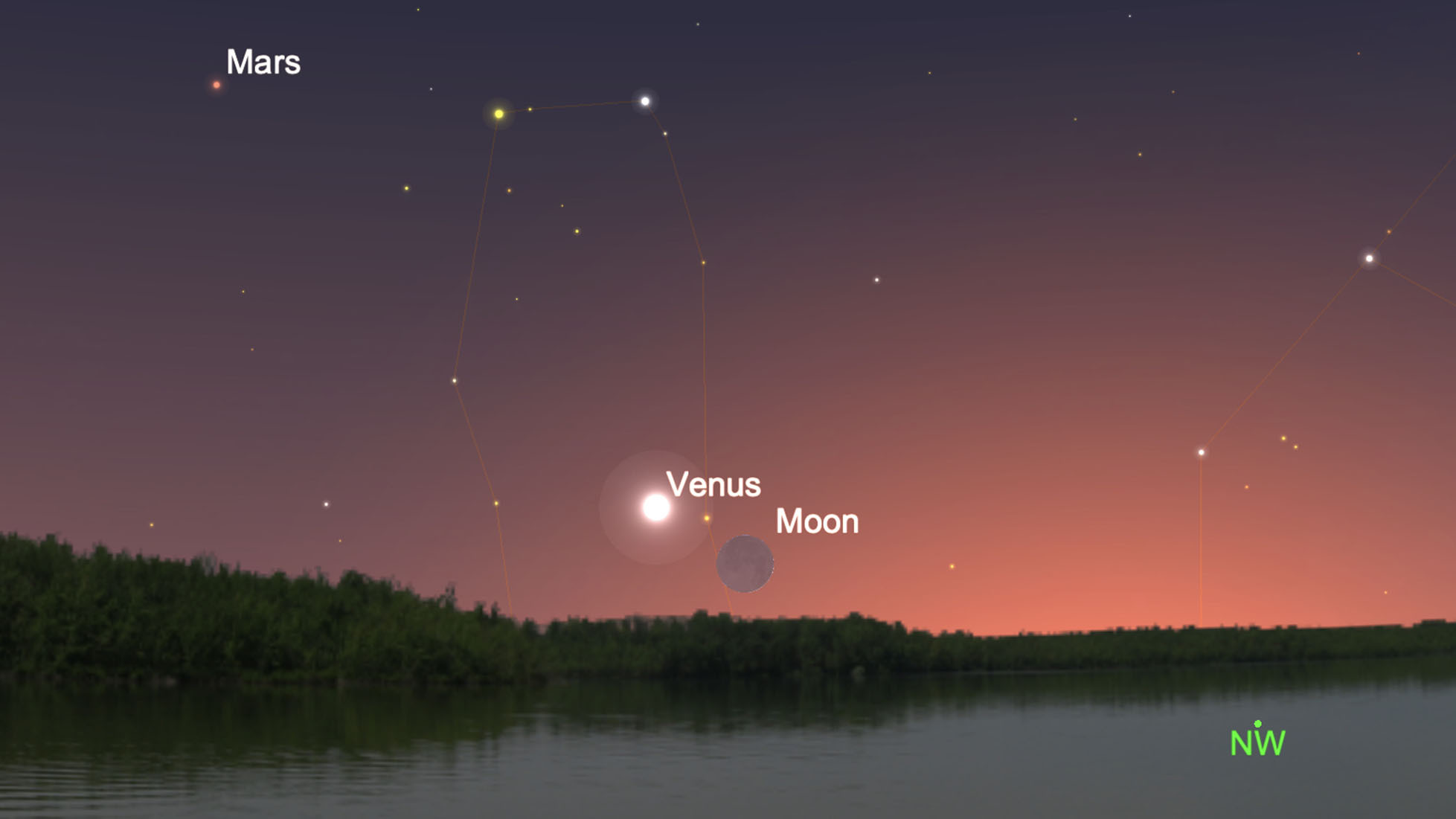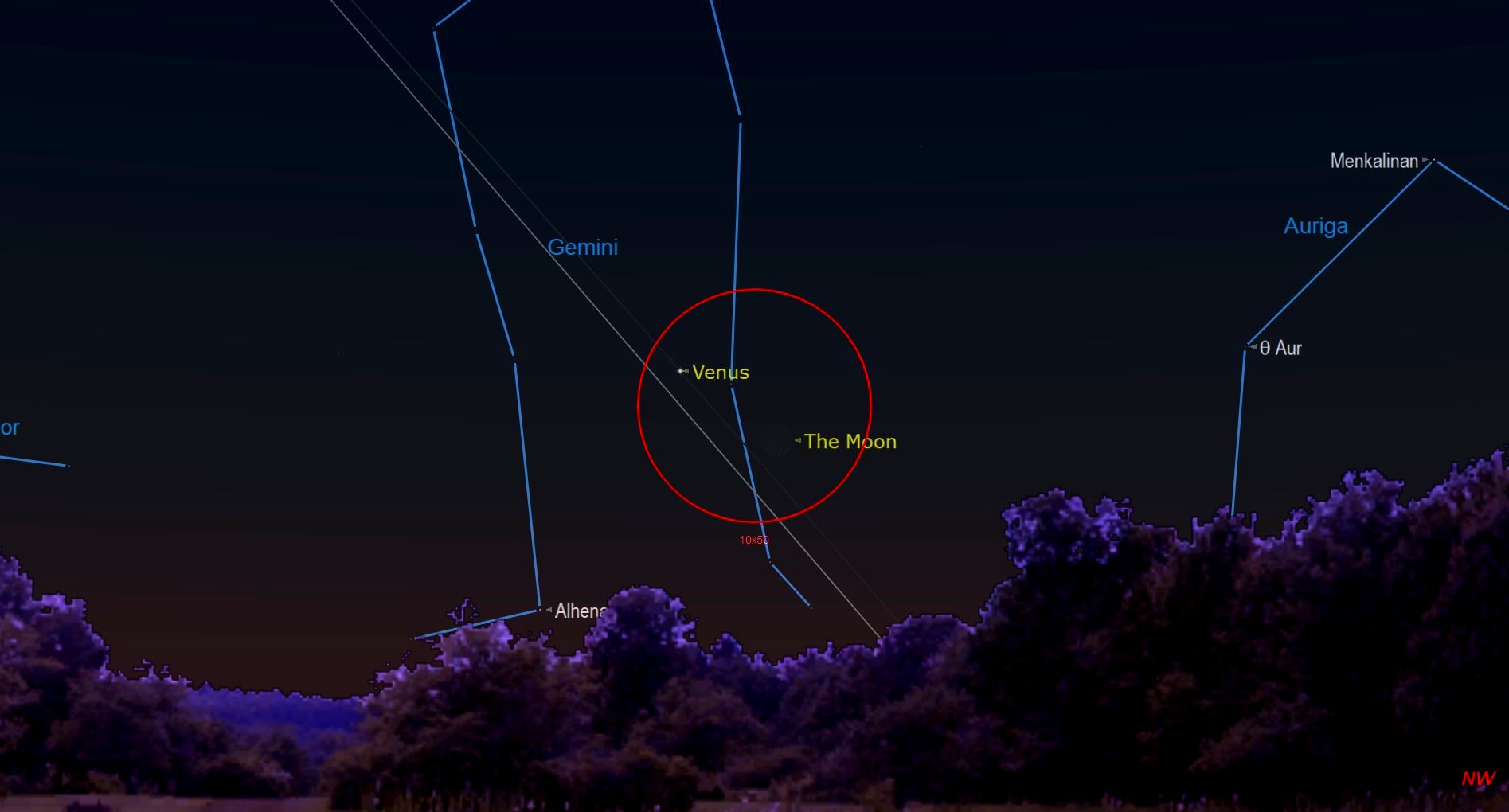
Tonight (June 11), just 38 hours after the moon rendezvoused with the sun to produce the "ring of fire" solar eclipse, our rocky satellite will pair off with the second brightest object in the night sky: Venus.
As day turns to night, roughly 45 minutes after sunset tonight, take a look toward the west-southwest part of the sky for a beautiful celestial tableau formed by the slender sliver of a crescent moon, just 3% illuminated, and the brilliant planet Venus. Venus will appear to hover just 4 degrees above and to the left of the moon.
Venus-moon pairings like this occur on roughly a monthly schedule. To catch the two together in the night sky again, check out the table at the end of this article to see the schedule for the remainder of this year.
Related: Planet Venus: Quiz yourself on Venus facts
Peregrinations of Venus and the moon
If Venus were stationary and did not appear to move against the night sky, then a Venus-moon encounter would occur every 27 days, 7 hours and 43 minutes. This is called a "sidereal month," or the length of time it takes the moon to circle the Earth once, using the background stars as a reference point.
Since Venus and the moon were close together on May 12, we might have expected another close pairing this past Tuesday (June 8) if the pair applied to the "sidereal month rule."
But Venus is not stationary. Like all other planets in our solar system, it moves in its own orbit around the sun. From our earthly viewpoint, Venus has appeared to shift considerably to the east. Back on May 12, Venus was in the constellation of Taurus, the bull. But tonight, the planet will appear to have shifted nearly 40 degrees to the east where it currently resides in the constellation of Gemini, the twins.
Get the Space.com Newsletter
Breaking space news, the latest updates on rocket launches, skywatching events and more!
If you hold up your arm, your clenched fist held at arm's length measures approximately 10 degrees. Forty degrees is equal to roughly four fists. So the moon had to travel that much more across the sky to catch up to Venus. Since the moon appears to move across the sky at roughly 13 degrees per day, it needs three more days to catch up to Venus. That takes us to Friday evening, where once again we will be treated to an eye-catching sight, though it will be rather low in our west-northwestern twilight sky.
Night sky, June 2021: What you can see this month [maps]

Earth's orbital movement factoring in
Incidentally, another factor that must also be considered is our own planet's movement around the sun. If you looked for the crescent moon this past Tuesday night, you would have had to look at the dawn sky to find — with difficulty — a thin, waning crescent moon, just two days before the new moon (and the annular solar eclipse).
That's because, during the 27 days that had elapsed since May 12, Earth's movement around the sun would have caused the sun's position in the sky to shift to the east as well. In this case, right into the same general region that Venus and the moon occupied on May 12.
By tonight, however, the moon will be well clear of the sun and visible low in the west-northwest with Venus. No other star or planet can come close to matching Venus in brilliance, not even bright Jupiter which this week comes up over the east-southeast horizon.
Venus is so brilliant in the night sky that, during World War II, aircraft spotters sometimes mistook the planet for an enemy airplane. There have even been cases where Venus drew antiaircraft fire!
A return to 2013
Venus repeats its performances in an eight-year cycle, so the planet's display in the sky this year is a close replay of 2013. The character of each year of the cycle is shaped by the timing of the planet's movements: for 2012/2020 the movement of the planet was very exciting, including a passage through the Pleiades star cluster in 2020 and a rare transit of the sun in 2012. However, for 2013/2021 they are relatively drab (as viewed from the Northern Hemisphere).
One feature of Venus this year is a dip to a southernmost declination near the beginning and another, more extreme, near the end. After shining low in the east for early risers in January and February, Venus climbed out as the "Evening Star" in the latter part of April. Standing a little higher after each sunset in May and June, the planet is seen in the company of the planet Mercury and the stars Aldebaran and Pollux.
Its arch carries it less high than last year and from July it ceases to climb. This is because it is sliding southeastward, ahead of the sun, down through the stars of Cancer, Leo, Virgo and Libra. On Nov. 5 the planet will be farthest south in our sky. In fact, it hasn't been this far south since 1930.
Thereafter — during the final eight weeks of the year — Venus will finally climb to a somewhat reasonable height above the west-southwest horizon by Thanksgiving and sets almost 3 hours after sunset. Shortly thereafter, however, it begins its slide down the sunset sky.
During the winter holiday season, it will provide the equivalent of a "Christmas Star," glowing like a beacon low in the west-southwest sky shortly after sundown. Finally, its next passage will come in front of (and 5 degrees north of) the sun on Jan. 10, 2022.
| Date | % of moon illuminated | Venus-moon separation |
|---|---|---|
| July 11 | 6% | 6 degrees |
| Aug. 10 | 9% | 6 degrees |
| Sept. 9 | 13% | 4.5 degrees |
| Oct. 9 | 15% | 2 degrees |
| Nov. 7 | 16% | 4.5 degrees |
| Dec. 6 | 11% | 3.5 degrees |
In the above chart, the first column gives the date, the second column provides the% of illumination of the crescent moon and the third column provides the separation between the moon and Venus.
In my opinion, the two best skywatching opportunities (of the six listed above) will occur on Sept. 9, when the moon and Venus form a triangle with the nearby blue first-magnitude star, Spica and then on Dec. 6, when Venus will stand almost directly above the moon while shining at her greatest brilliance at magnitude -4.7 — twice as bright as it appears now! Both will appear like a celestial holiday ornament adorning the low west-southwest sky: Venus a dazzling white light, and the moon — with Earthshine — mimicking an eerily illuminated yellow and blue Christmas ball.
Joe Rao serves as an instructor and guest lecturer at New York's Hayden Planetarium. He writes about astronomy for Natural History magazine, the Farmers' Almanac and other publications. Follow us on Twitter @Spacedotcom and on Facebook.
Join our Space Forums to keep talking space on the latest missions, night sky and more! And if you have a news tip, correction or comment, let us know at: community@space.com.

Joe Rao is Space.com's skywatching columnist, as well as a veteran meteorologist and eclipse chaser who also serves as an instructor and guest lecturer at New York's Hayden Planetarium. He writes about astronomy for Natural History magazine, Sky & Telescope and other publications. Joe is an 8-time Emmy-nominated meteorologist who served the Putnam Valley region of New York for over 21 years. You can find him on Twitter and YouTube tracking lunar and solar eclipses, meteor showers and more. To find out Joe's latest project, visit him on Twitter.









